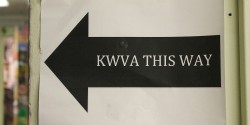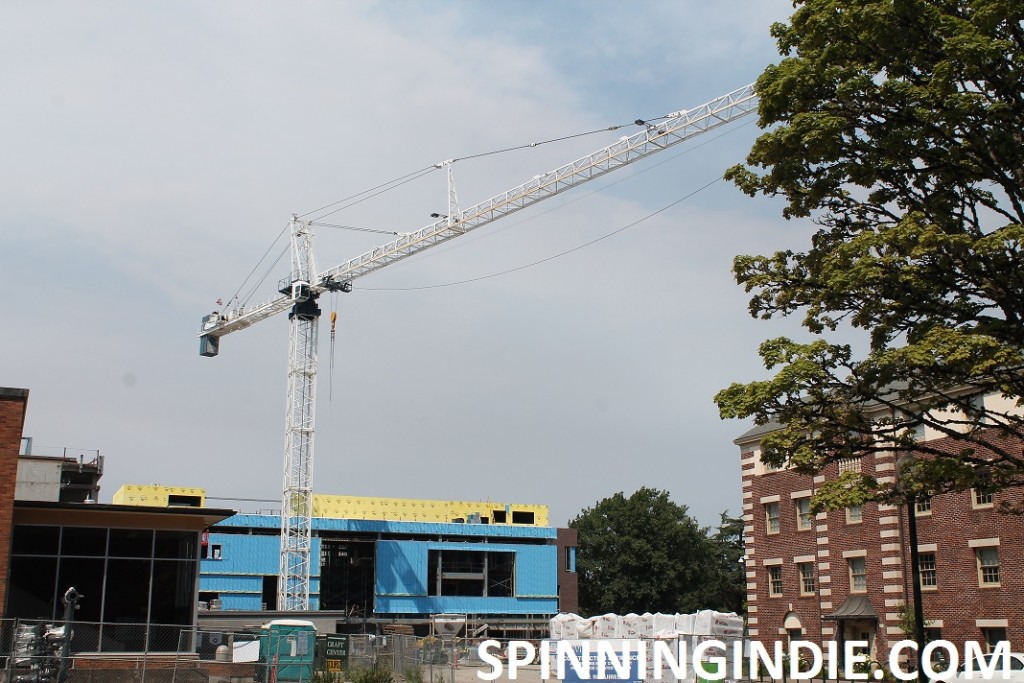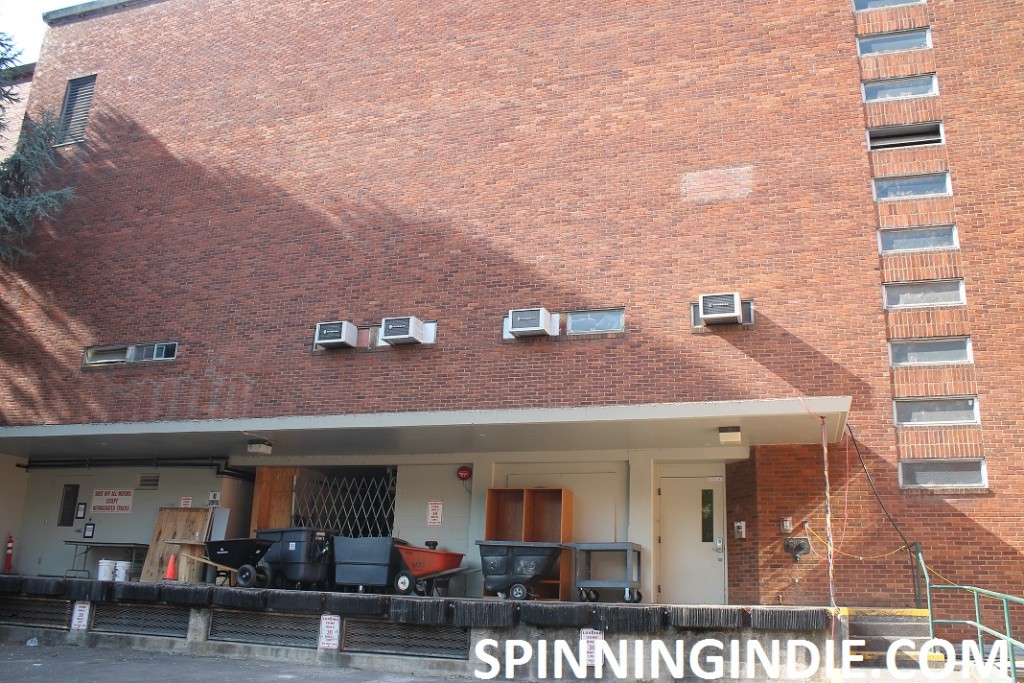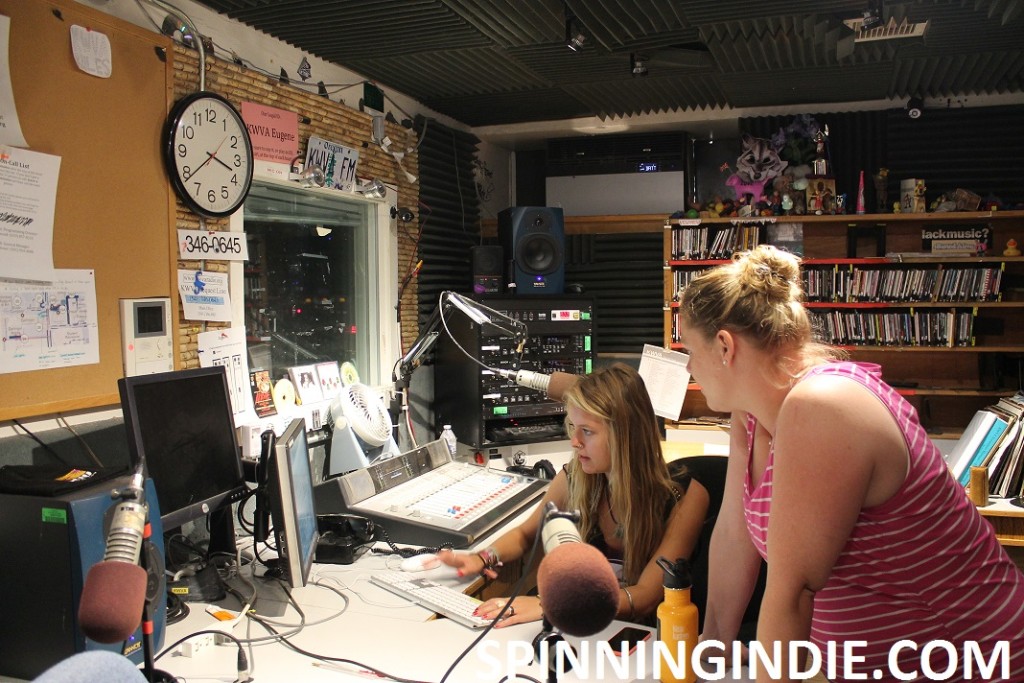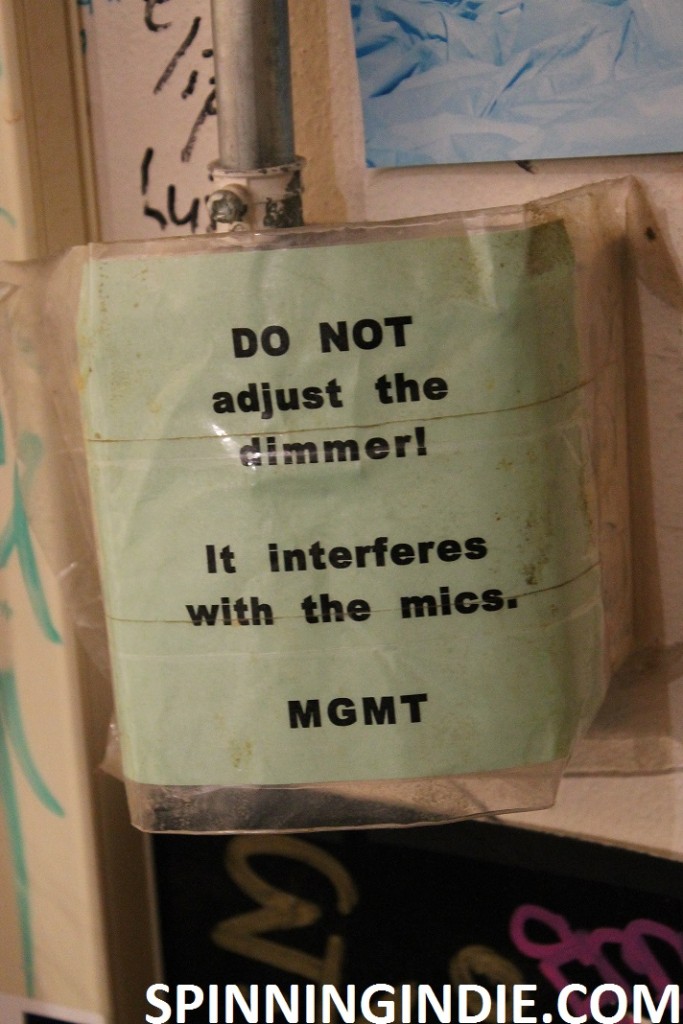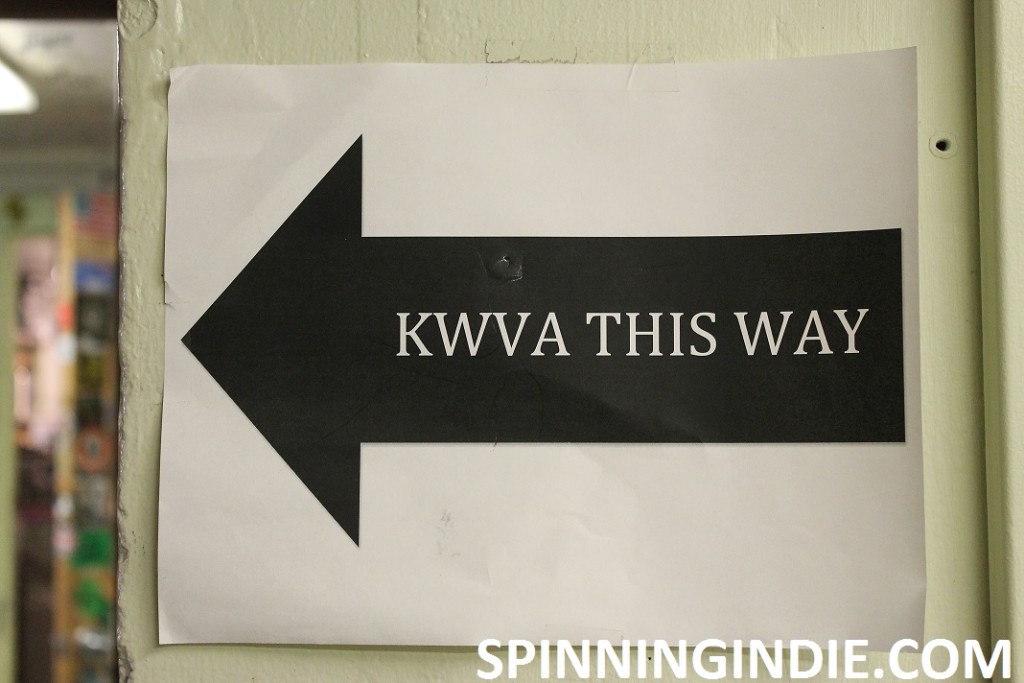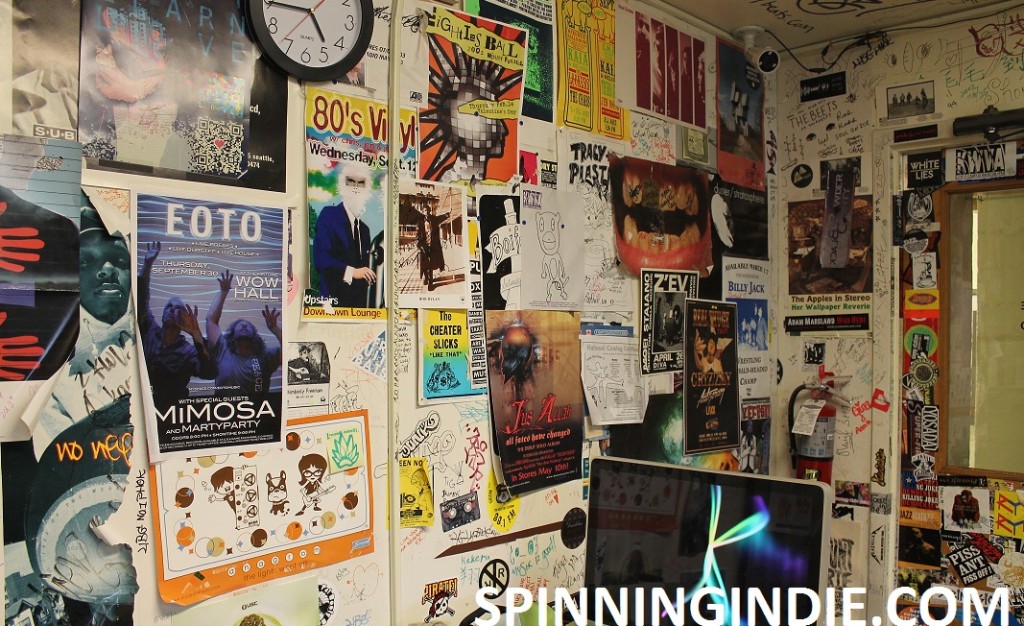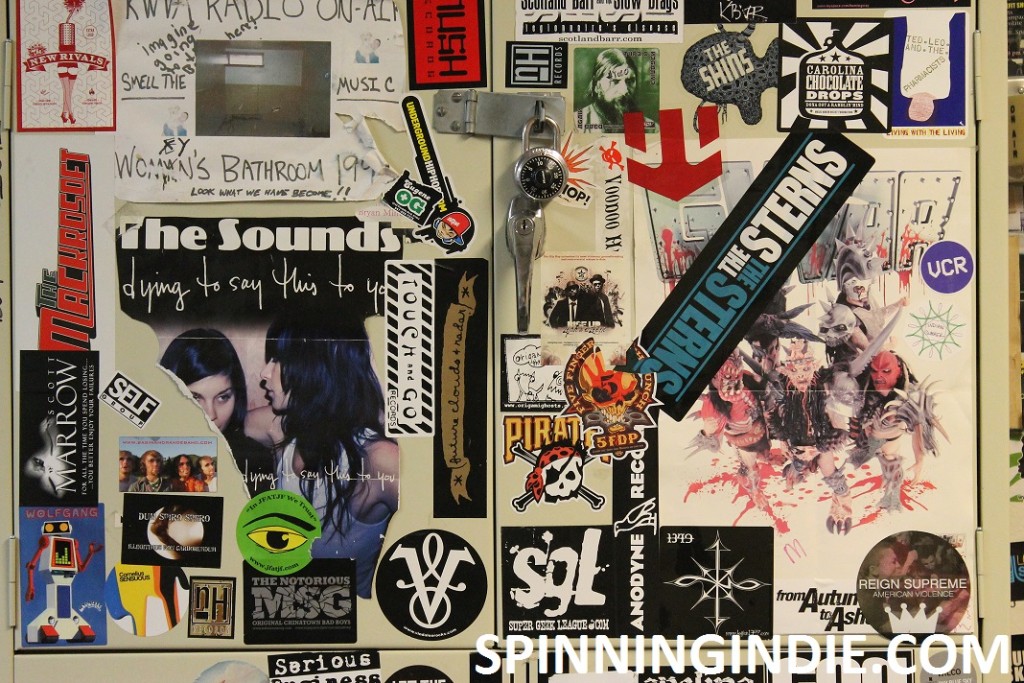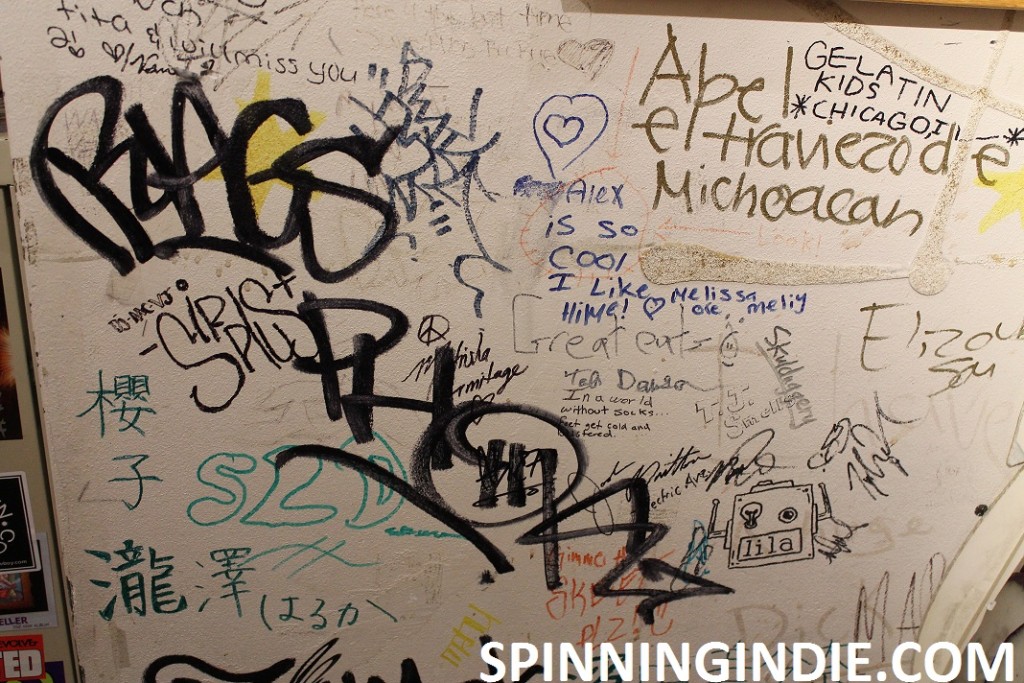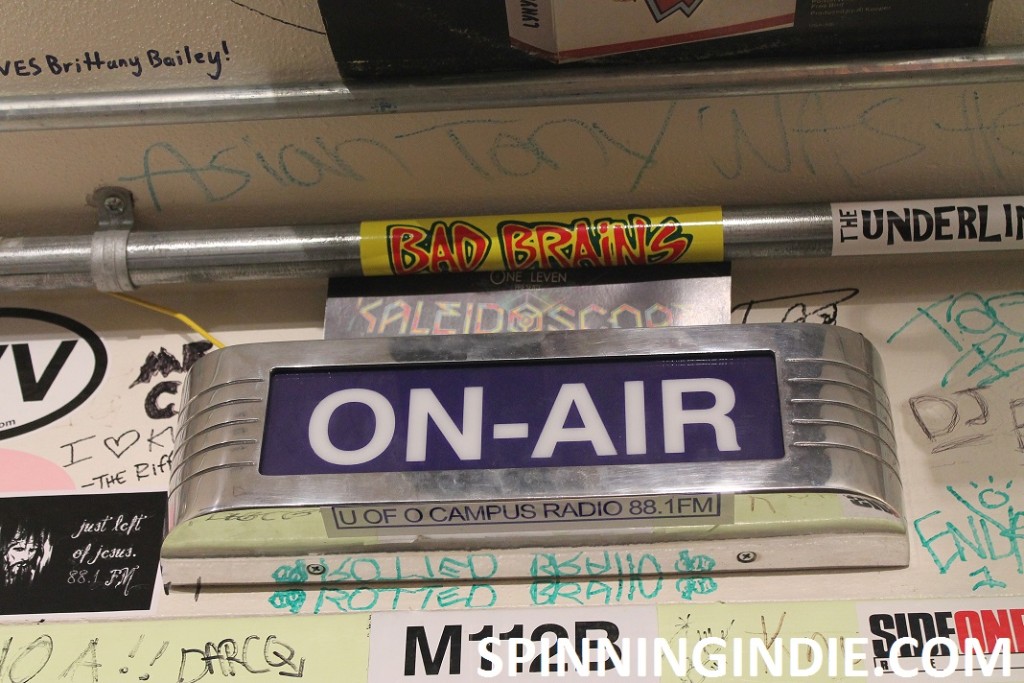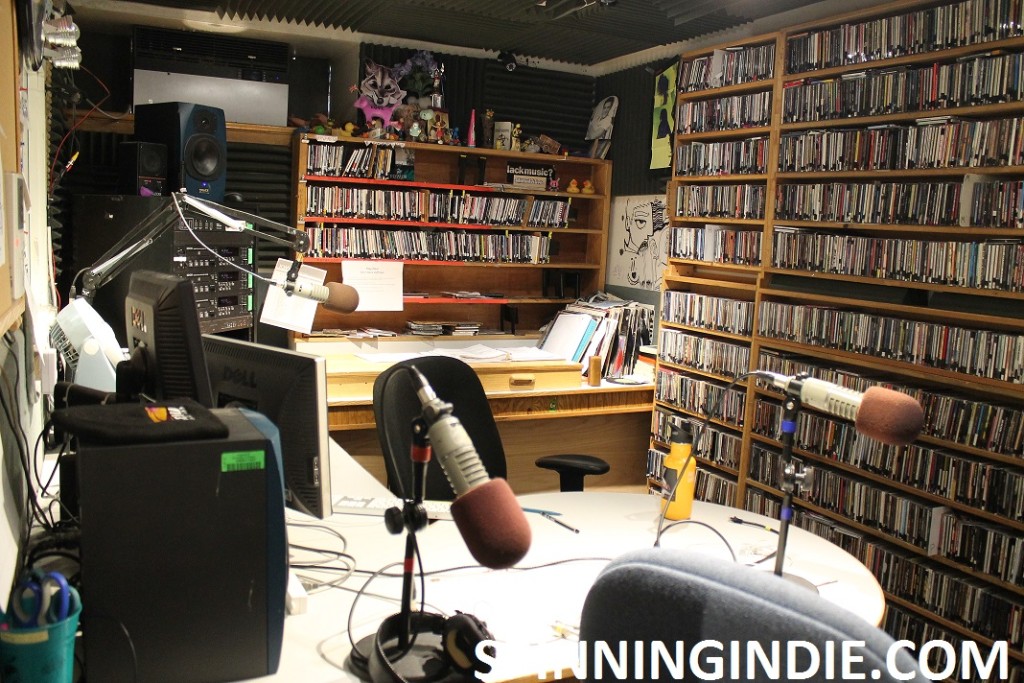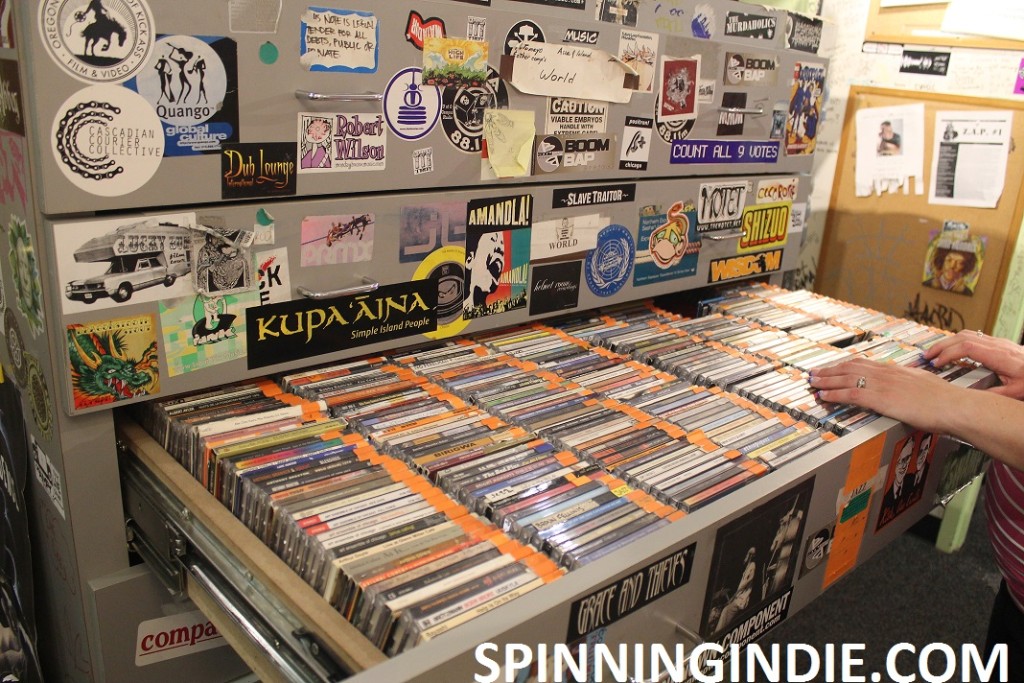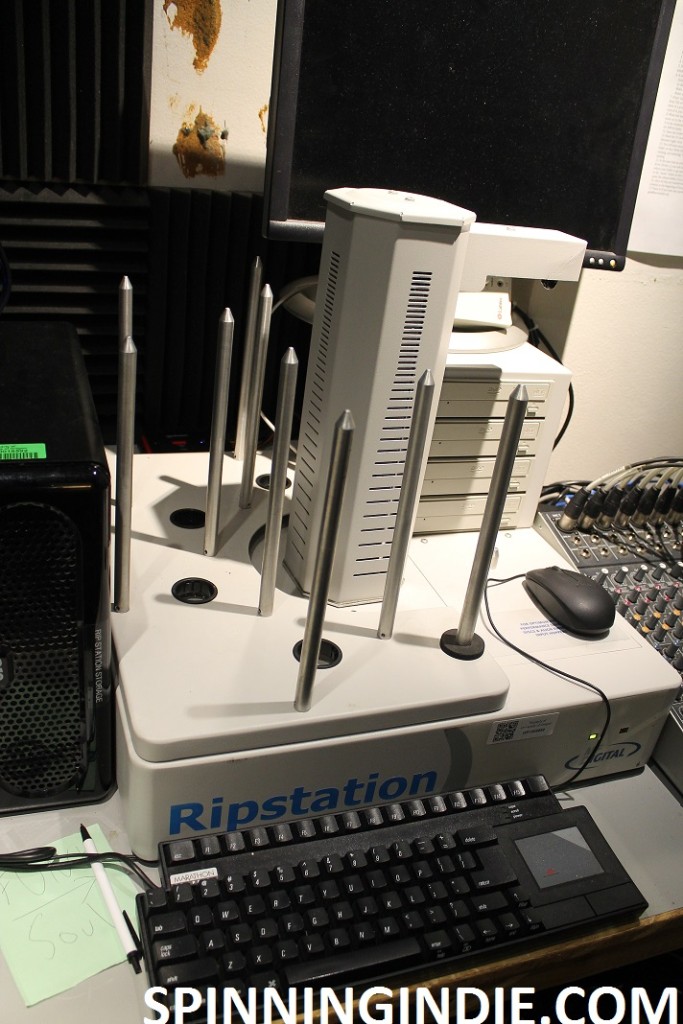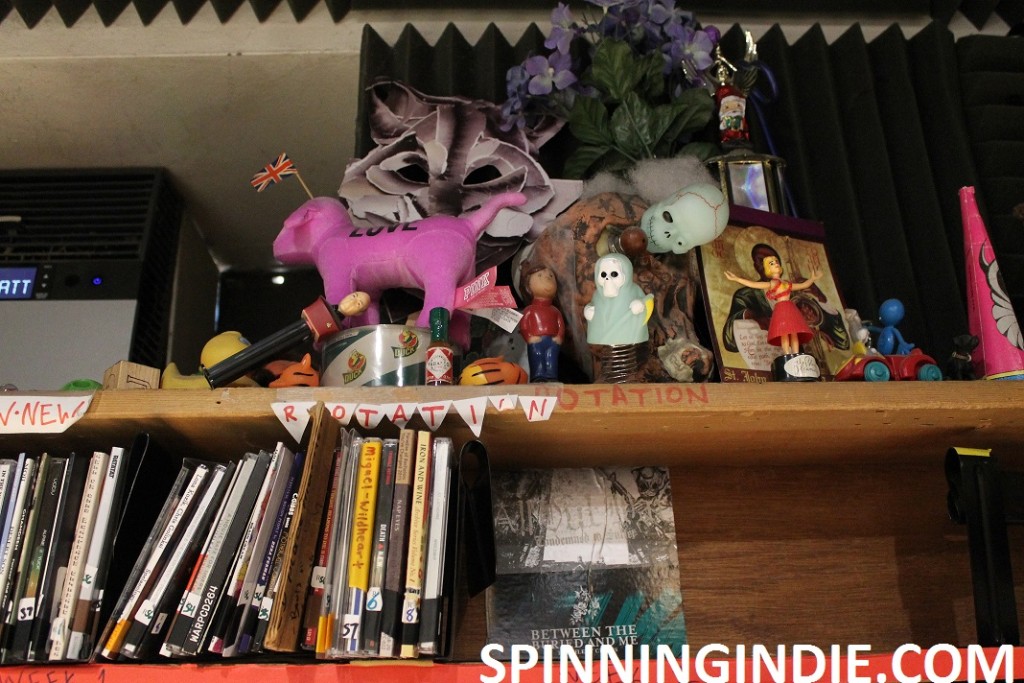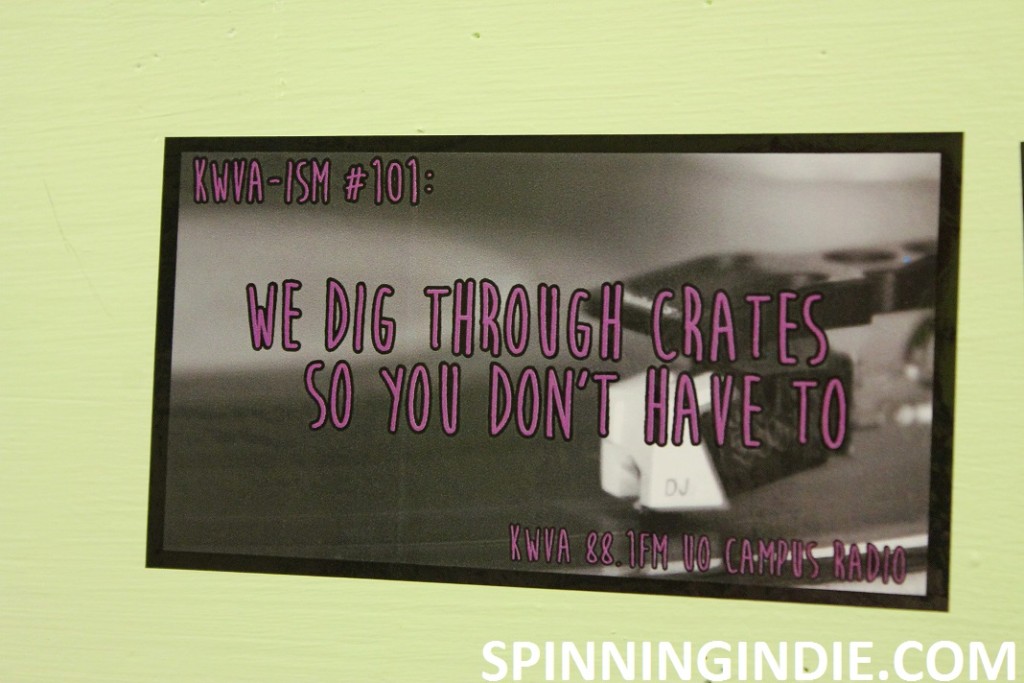For a family vacation to the Pacific Northwest earlier this month, I proposed a road trip, in part because I hoped to see some radio stations along the way. As we set out on our second day of travel on Saturday, August 1st, our first radio destination was University of Oregon’s college radio station KWVA-FM in Eugene, Oregon. As we got closer to Eugene, the air was thick with smoke from wildfires and the weather was unseasonably hot (especially for us San Franciscans).
It was probably 95 degrees when we got to the quiet campus at around 3:00 in the afternoon. KWVA General Manager Charlotte Nisser was en route and told us to meet her at the loading dock of the Erb Memorial Union building. Major construction is taking place and the Union building was closed to visitors, but after greeting us, Nisser ushered us into the building. Located on the mezzanine level above a food court and near the freight elevators, KWVA is off the beaten path and is “not an area that many people find,” according to Nisser.
KWVA was a welcome relief from the heat, as its air conditioning kept the station incredibly cool (not always the case at college radio stations). Even though the building was closed, the tucked-away station was abuzz with activity. With live DJs 24 hours a day, 7 days a week, there’s always someone in the booth. The day of our visit was a bit different, as KWVA was doing a live remote broadcast from a nearby festival, the Whiteaker Block Party. In its 9th year, the event features multiple stages and a wide range of music, spoken word, comedy, and more. KWVA has broadcast from the event most years. When we got to the station they were already several hours into the broadcast and expected to be on the air with live music and performances from the main stage of the festival until 10 pm.
KWVA (whose call letters stand for “Willamette Valley Alternative”) launched in 1993 as a student radio station. Today it has around 150 volunteers from both the school and the nearby community and its mission is to provide content that isn’t available elsewhere. The station airs music shows (typically 1 to 2 hours in length), news, and sports programming (including a live sports talk show and a wide variety of games, including women’s lacrosse, softball, soccer, and volleyball).
The KWVA schedule has contained a wide variety of public affairs programs in recent years, including a prison-themed show (Concertina Wire, which I first learned about during a panel at the What is Radio? Conference back in 2013) and talk shows focused on the Occupy movement, campus news, and alternative politics. On Radio Survivor Podcast #9, Nisser shared with me that the station got some press attention when it was revealed that recordings had surfaced of Adam Lanza (who committed a mass murder at Sandy Hook Elementary School in 2012) calling in to the KWVA show Anarchy Radio.
KWVA wasn’t the first college radio station on campus and one of its predecessors, KWAX-FM, now operates on 91.1 FM as a professionally-run classical music station after starting out as a student-run station in the 1950s. Its license is still held by the University of Oregon. After KWAX transitioned away from being a student-run station, there was still demand on campus for a true college radio station. Luckily a frequency dropped into the school’s lap. According to Nisser, a community member donated the 88.1 FM license, which was originally supposed to be air children’s programming through a deal with KWAX. There was already great interest in creating a student radio station, so it was an exciting turn of events to get college radio back on campus.
The station’s main office/lobby is full of personality, with pretty much every inch of the walls and much of the ceiling covered with posters, stickers, and graffiti. The room also serves as a live performance space. Nisser pointed out a wire close to the ceiling where a curtain can be hung for sound dampening. Cameras also get set up and performances are recorded and archived on the KWVA YouTube channel. Visiting performers often sign the lobby walls, adding to the dizzying amount of art and writing throughout the space. With a move on the horizon in the next year, Nisser told me that she’s trying to figure out ways to preserve the history that fills the station’s walls.
The Union building is in the midst of a huge renovation and KWVA will be moving to a larger space in the basement that once housed a bowling alley and billiards tables. The location will be a bit easier to find, as it will be close to a coffee shop and other high-trafficked spots in the basement. It will also be a big upgrade for KWVA, as it’s currently in a cramped space from the 1950s that’s been modified over the years to accommodate the radio station. Nisser’s office still sports a tile floor that hints at its past life as a men’s restroom and KWVA’s studio used to be a women’s restroom. After the renovation, the current KWVA space will be converted into offices.
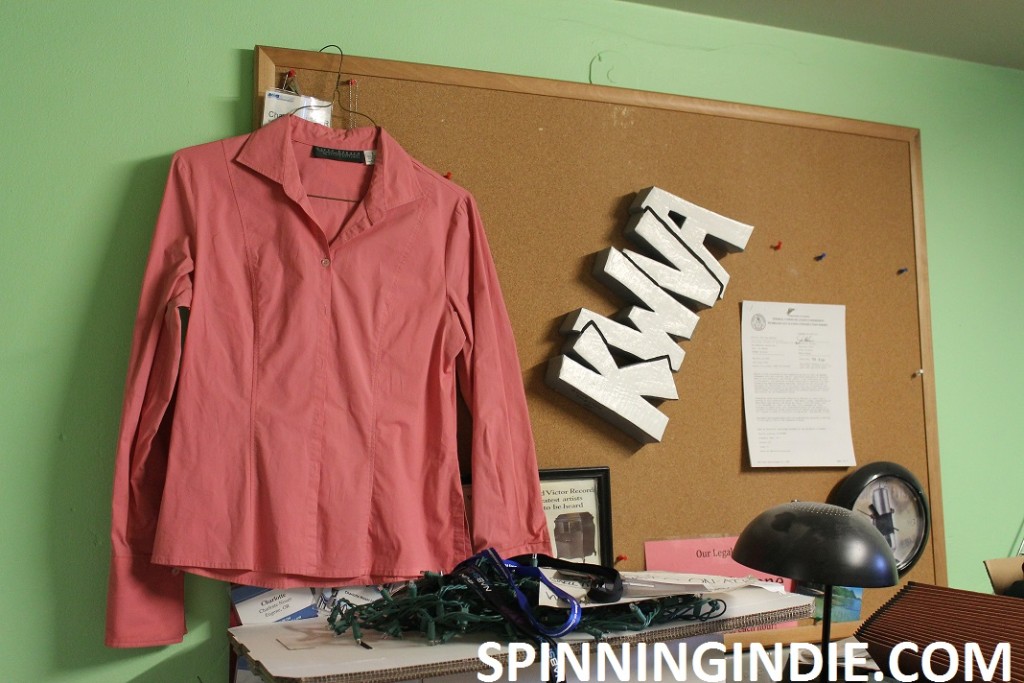
There’s that Leo Blais sign again! Tucked away in Charlotte Nisser’s office at KWVA. Photo: J. Waits
Although she’s excited to have a new radio station space three times the size of its current home, with room for two on-air studios, two production studios, and a large record library, Nisser acknowledged that inhabiting a pristine, new space will also be an adjustment. With brand new furniture and freshly painted walls, it’s unclear if KWVA will be able to bring its sticker-covered cabinets or other funky station artifacts.
It may also mean the end of graffiti and of the tradition of visiting musicians signing the walls. Nisser told me that it remains to be seen, as they will need to bring necessary radio station equipment and storage with them to the new location. There’s still a bit of time left to plan, as it’s expected that KWVA will need to move by May, 2016. Nisser said that she hopes to have an event before then so that station alumni can come and say goodbye to the long-time space.
As we chatted in the station lobby, a number a station staffers and volunteers wandered through. Music from the festival emanated from speakers at the top of the wall and a nearly empty box of Voodoo Donuts occupied one of the chairs.
Beyond the lobby, there are a few small production studios and the on-air studio (known as “studio A”) and a few offices are located down the hall from the station. There’s always a live DJ in the studio and the space contains a collection of CDs as well as three CD players, two turntables that can be used in typical fashion or for mixing, and an automation system (MegaSeg) that allows for coverage if there’s no DJ in the studio and also makes it easier to air syndicated programs (like Democracy Now) as well as promotional messages and stations IDs on digital carts.
DJs can also bring in their own equipment in order to play cassettes (a DJ that hosts a noise show regularly plays cassettes) or digital files. Music that’s in regular rotation at KWVA is housed on CDs and there’s a library of CDs both in the studio and in file drawers in the station hallway. I only spotted a few stray vinyl records during my visit (including a Dolly Parton LP in a production studio and a Star Wars 7″ tucked away in an office) and Nisser said that because of the limited space and planned move, vinyl was housed in deep storage away from the station. After the move it will re-emerge and will once again be accessible to DJs as it will live in a brand new music library.
Even though new music added to the station is largely played from CDs (some of which are created from digital files), KWVA is in the midst of a digitization project and has a dedicated piece of equipment called a Ripstation in order to create digital files from the station’s physical music library. DJs play from a wide variety of sources, with younger DJs more likely to bring in laptops, iPods, and hard drives and older DJs more likely to play a mix of content from vinyl, CDs, and digital files. There are also some DJs who do vinyl-only shows and a few who play cassettes.
DJs with “rotation” shows must play four tracks an hour from the collection of new CDs at KWVA. Non-rotation shows (for example, a show that focuses on music from the 1980s) are exempt from this rule. Nisser said that at KWVA they avoid the use of the term “specialty shows,” as every show should in theory be “special.” In order to support show hosts and DJs with regular shows, KWVA added a second stream last year so that the station could continue to air its regular programming on another webstream during sports broadcasts. She said it was a great solution so that DJs could continue to do their regular shows without getting pre-empted by live sports.
Thanks so much to Charlotte Nisser for the summertime tour of KWVA. I wish the station well as it prepares for its move to new digs next year. If you want to hear more about this field trip, tune in to Radio Survivor Podcast #9, in which I talk about my visit and also include some audio clips from my interview with Nisser. Also, as a thank you to our Radio Survivor Patreon supporters who are eligible for exclusive Radio Survivor content, I’ll be sharing some additional photos from this visit on our Patreon page.
This is my 88th station tour report. I still have another D.C. station trip to write up in addition to two more visits from my Pacific Northwest travels (one is in Oregon and the other is in Washington). See my most recent field trips on Radio Survivor and see all of my station field trips on Spinning Indie.

